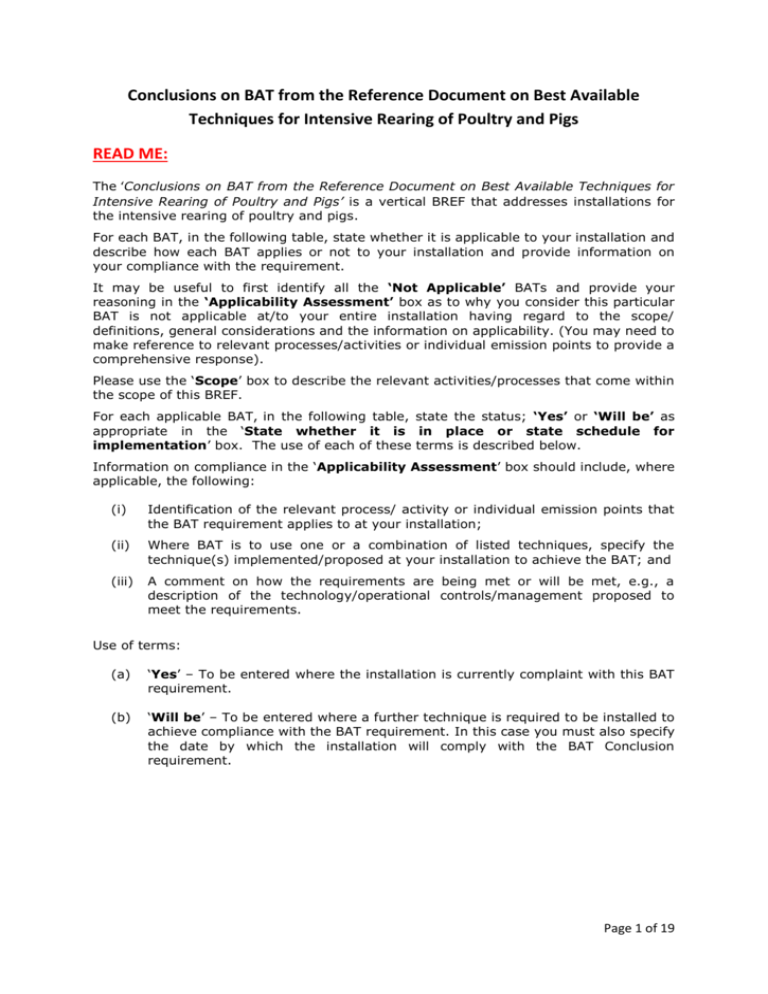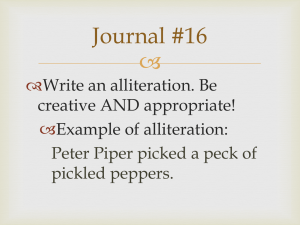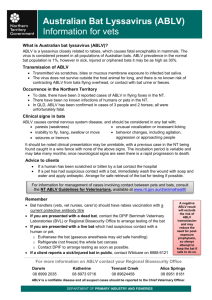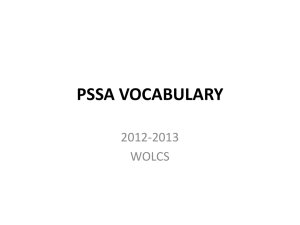5.2 Intensive Rearing of Pigs
advertisement

Conclusions on BAT from the Reference Document on Best Available Techniques for Intensive Rearing of Poultry and Pigs READ ME: The ‘Conclusions on BAT from the Reference Document on Best Available Techniques for Intensive Rearing of Poultry and Pigs’ is a vertical BREF that addresses installations for the intensive rearing of poultry and pigs. For each BAT, in the following table, state whether it is applicable to your installation and describe how each BAT applies or not to your installation and provide information on your compliance with the requirement. It may be useful to first identify all the ‘Not Applicable’ BATs and provide your reasoning in the ‘Applicability Assessment’ box as to why you consider this particular BAT is not applicable at/to your entire installation having regard to the scope/ definitions, general considerations and the information on applicability. (You may need to make reference to relevant processes/activities or individual emission points to provide a comprehensive response). Please use the ‘Scope’ box to describe the relevant activities/processes that come within the scope of this BREF. For each applicable BAT, in the following table, state the status; ‘Yes’ or ‘Will be’ as appropriate in the ‘State whether it is in place or state schedule for implementation’ box. The use of each of these terms is described below. Information on compliance in the ‘Applicability Assessment’ box should include, where applicable, the following: (i) Identification of the relevant process/ activity or individual emission points that the BAT requirement applies to at your installation; (ii) Where BAT is to use one or a combination of listed techniques, specify the technique(s) implemented/proposed at your installation to achieve the BAT; and (iii) A comment on how the requirements are being met or will be met, e.g., a description of the technology/operational controls/management proposed to meet the requirements. Use of terms: (a) ‘Yes’ – To be entered where the installation is currently complaint with this BAT requirement. (b) ‘Will be’ – To be entered where a further technique is required to be installed to achieve compliance with the BAT requirement. In this case you must also specify the date by which the installation will comply with the BAT Conclusion requirement. Page 1 of 19 Conclusions on BAT from the Reference Document on Best Available Techniques for Intensive Rearing of Poultry and Pigs (July 2003) (extracts) The full and complete Reference Document on Best Available Techniques for Intensive Rearing of Poultry and Pigs (July 2003) is available at the EIPPC Bureau website: http://eippcb.jrc.ec.europa.eu/reference/ SCOPE Identify here the particular processes and activities at the installation that come within the scope of the conclusions on BAT from the Intensive Rearing of Poultry and Pigs BAT reference documents (BREF). Application of organic fertiliser to land outside the installation boundary will not be controlled by conditions of an IED licence, however the BREF document for Intensive Rearing of Poultry and Pigs (2003) includes BAT conclusions on techniques for landspreading of manure. The IPPC Bureau, in relation to the draft BREF (predicted to be finalised during 2015), states that ‘The Scope of the BAT Conclusions does not make any distinction as to whether the manure is spread on farm or off farm. It is up to the competent authority to assess on a case by case basis whether the land where manure spreading is carried out is located on the site, therefore constituting part of the ‘installation’. Conclusions on BAT Applicability Assessment (describe how the technique applies or not to your installation) State whether it is in place or state schedule for implementation 5.1 Good agricultural practice in the intensive rearing of pigs and poultry (BAT 1-11 below apply to both pig and poultry sites) BAT 1. BAT is to identify and implement education and training programmes for farm staff (Section 4.1.2) BAT 2. BAT is to keep records of water and energy usage, amounts of livestock feed, waste arising and field applications of inorganic fertiliser and manure (Section 4.1.4) Page 2 of 19 BAT 3. BAT is to have an emergency procedure to deal with unplanned emissions and incidents (Section 4.1.5) BAT 4. BAT is to implement a repair and maintenance programme to ensure that structures and equipment are in good working order and that facilities are kept clean (Section 4.1.6) BAT 5. BAT is to plan activities at the site properly, such as the delivery of materials and the removal of products and waste (Section 4.1.3), BAT 6. BAT is to plan the application of manure to land properly (Section 4.1.3). BAT 7. BAT is to apply nutritional measures at source by feeding pigs and poultry lower amounts of nutrients; see Sections 5.2.1 and 5.3.1. BAT 8. BAT is to minimise emissions from manure to soil and groundwater by balancing the amount of manure with the foreseeable requirements of the crop (nitrogen and phosphorus, and the mineral supply to the crop from the soil and from fertilisation). BAT 9. BAT is to take into account the characteristics of the land concerned when applying manure; in particular soil conditions, soil type and slope, climatic conditions, rainfall and irrigation, land use and agricultural practices, including crop rotation systems. BAT 10. BAT is to reduce pollution of water by doing in particular all of the following: not applying manure to land when the field is: - water-saturated - flooded - frozen - snow covered not applying manure to steeply sloping fields not applying manure adjacent to any watercourse (leaving an untreated strip of land), and spreading the manure as close as possible before maximum crop growth and nutrient Page 3 of 19 uptake occur. BAT 11. BAT is managing the landspreading of manure to reduce odour nuisance where neighbours are likely to be affected, by doing in particular all of the following: - spreading during the day when people are less likely to be at home and avoiding weekends and public holidays, and - paying attention to wind direction in relation to neighbouring houses. 5.2 Intensive Rearing of Pigs (BAT 12 to 51 below apply to Pig sites only) 5.2.1 Nutritional techniques Nutritional management aims at matching feeds more closely to animal requirements at various production stages, thus decreasing the wasted nutrient excretion in the manure. 5.2.1.1 Nutritional techniques applied to nitrogen excretion BAT 12. BAT is to apply feeding measures. As far as nitrogen and consequently nitrates and ammonia outputs are concerned, a basis for BAT is to feed animals with successive diets (phase-feeding) with lower crude protein contents. These diets need to be supported by an optimal amino acid supply from adequate feedstuffs and/or industrial amino acids (lysine, methionine, threonine, tryptophan, see Section 4.2.3). A crude protein reduction of 2 to 3 % (20 to 30 g/kg of feed) can be achieved depending on the breed/genotype and the actual starting point. The resulting range of dietary crude protein contents is reported in Table 5.1. The values in the table are only indicative, because they, amongst others, depend on the energy content of the feed. Therefore levels may need to be adapted to local conditions. Research on further applied nutrition is currently being carried out in a number of Member States and may support further possible reductions in the future, depending on the effects of changes in Page 4 of 19 genotypes. 5.2.1.2 Nutritional techniques applied to phosphorus excretion BAT 13. BAT is to apply feeding measures. As far as phosphorus is concerned, a basis for BAT is to feed animals with successive diets (phase-feeding) with lower total phosphorus contents. In these diets, highly digestible inorganic feed phosphates and/or phytase must be used in order to guarantee a sufficient supply of digestible phosphorus. A total phosphorus reduction of 0.03 to 0.07 % (0.3 to 0.7 g/kg of feed) can be achieved depending on the breed/genotype and the actual starting point by the application of highly digestible inorganic feed phosphates and/or phytase in the feed. The resulting range of dietary total phosphorus contents is reported in Table 5.2. The values in the table are only indicative, because they, amongst others, depend on the energy content of the feed. Therefore levels may need to be adapted to local conditions. Further applied nutrition research is currently being carried out in a number of Member States and may support further possible reductions in the future, depending on the effects of changes in genotypes. Page 5 of 19 5.2.2 Air emissions from pig housing Designs to reduce ammonia emissions to air from pig housing systems, as presented in Chapter 4, basically involve some or all of the following principles: _ reducing emitting manure surfaces _ removing the manure (slurry) from the pit to an external slurry store _ applying an additional treatment, such as aeration, to obtain flushing liquid _ cooling the manure surface _ using surfaces (for example, of slats and manure channels) which are smooth and easy to clean. The draft BREF (predicted to be finalised during 2015) identifies ‘Fully or partly slatted floor with a deep pit’ However in relation to applicability the housing technique is ‘Not applicable to new plants, unless combined with an air cleaning system, slurry cooling and/or pH reduction of the slurry. Only applicable to existing plants if used in combination with an additional mitigation measure, e.g. a combination of nutritional techniques, air cleaning system, pH reduction of the slurry, slurry cooling’. 5.2.2.1 Housing systems for mating/gestating sows BAT 14 BAT is: Page 6 of 19 - a fully- or partly-slatted floor with vacuum system for frequent slurry removal (Sections 4.6.1.1 and 4.6.1.6), or a partly-slatted floor and a reduced manure pit (Section 4.6.1.4). BAT 15 ‘New to build housing systems with a fully- or partly-slatted floor and flush gutters or tubes underneath and flushing is applied with non-aerated liquid (Sections 4.6.1.3 and 4.6.1.8)’ are conditional BAT. In instances where the peak in odour, due to the flushing, is not expected to give nuisance to neighbours these techniques are BAT for new to build systems. In instances where this technique is already in place, it is BAT (without condition). BAT 16. ‘A housing system with manure surface cooling fins using a closed system with heating pumps (Section 4.6.1.5)’ performs well but is a very costly system. Therefore manure surface cooling fins are not BAT for new to build housing systems, but when it is already in place, it is BAT. BAT 17. ‘Partly-slatted floor systems with a manure scraper underneath (Section 4.6.1.9)’ generally perform well, but the operability is difficult. Therefore a manure scraper is not BAT for new to build housing systems, but it is BAT when the technique is already in place. BAT 18. ‘Fully- or partly-slatted floor systems and flushing gutters or tubes underneath with flushing applied with non-aerated liquid (Sections 4.6.1.3 and 4.6.1.8)’ is, as already mentioned earlier, BAT when it is already in place. The same technique operated with aerated liquid is not BAT for new to build housing systems because of odour peaks, energy consumption and operability. However, in instances where this technique is already in place, it is BAT. BAT 19. When litter is used, along with good practices such as having enough litter, changing the litter frequently, designing the pen floor suitably, and creating functional areas, then they cannot be excluded as BAT. 5.2.2.2 Housing systems for growers/finishers BAT 20. BAT is: Page 7 of 19 - a fully-slatted floor with a vacuum system for frequent removal (Section 4.6.1.1), or a partly-slatted floor with a reduced manure pit, including slanted walls and a vacuum system (Section 4.6.4.3), or a partly-slatted floor with a central, convex solid floor or an inclined solid floor at the front of the pen, a manure gutter with slanted sidewalls and a sloped manure pit (Section 4.6.4.2). BAT 21. ‘New to build housing systems with a fully- or partly-slatted floor and flush gutters or tubes underneath and flushing is applied with non-aerated liquid (Sections 4.6.1.3 and 4.6.1.8)’ are conditional BAT. In instances where the peak in odour, due to the flushing, is not expected to give nuisance to neighbours these techniques are BAT for new to build systems. In instances where this technique is already in place, it is BAT (without condition). BAT 22. ‘A housing system with manure surface cooling fins using a closed system with heating pumps (4.6.1.5)’ performs well but is a very costly system. Therefore manure surface cooling fins are not BAT for new to build housing systems, but when it is already in place, it is BAT. In retrofit situations this technique can be economically viable and thus can be BAT as well, but this has to be decided on a case by case basis. BAT 23. ‘Partly-slatted floor systems with a manure scraper underneath (4.6.1.9)’ generally perform well, but the operability is difficult. Therefore a manure scraper is not BAT for new to build housing systems, but it is BAT when the technique is already in place. BAT 24. ‘Fully- or partly-slatted floor systems and flushing gutters or tubes underneath with flushing applied with non-aerated liquid (Sections 4.6.1.3 and 4.6.1.8)’ is, as already mentioned earlier, BAT when it is already in place. The same technique operated with aerated liquid is not BAT for new to build housing systems because of odour peaks, energy consumption and operability. However, in instances where this technique is already in place, it is BAT. BAT 25 When litter is used, along with good practices such as having enough litter, changing the litter frequently, designing the pen floor suitably, and creating functional areas, then they cannot be excluded as BAT. Page 8 of 19 The following system is an example of what may be BAT: - a solid concrete floor with littered external alley and a straw flow system (Section 4.6.4.8). 5.2.2.3 Housing systems for farrowing sows (including piglets) BAT 26. BAT is a crate with a fully-slatted iron or plastic floor and with a: - combination of a water and manure channel (Section 4.6.2.2), or - flushing system with manure gutters (Section 4.6.2.3), or - manure pan underneath (Section 4.6.2.4). BAT 27. ‘A housing system with manure surface cooling fins using a closed system with heating pumps (Section 4.6.2.5)’ performs well but is a very costly system. Therefore manure surface cooling fins are not BAT for new to build housing systems, but when it is already in place, it is BAT. In retrofit situations this technique can be economically viable and thus can be BAT as well, but this has to be decided on a case by case basis. BAT 28. ‘Crates with a partly-slatted floor and a manure scraper underneath (Section 4.6.2.7)’ generally perform well, but the operability is difficult. Therefore a manure scraper is not BAT for new to build housing systems, but it is BAT when the technique is already in place. BAT 29. For new installations the following techniques are not BAT: - crates with a partly-slatted floor and a reduced manure pit (Section 4.6.2.6), and - crates with a fully-slatted floor and a board on a slope (Section 4.6.2.1). However, when these techniques are already in place it is BAT. BAT 30. When litter is used, along with good practices such as having enough litter, changing the litter frequently, and designing the pen floor suitably then they cannot be excluded as BAT. 5.2.2.4 Housing systems for weaners BAT 31. BAT is a pen: - or flatdeck with a fully-slatted- or partly-slatted floor with a vacuum system Page 9 of 19 - for frequent slurry removal (Sections 4.6.1.1 and 4.6.1.6), or a pen or flatdeck with a fully-slatted floor beneath which there is a concrete sloped floor to separate faeces and urine (Section 4.6.3.1), or with a partly-slatted floor (two-climate system) (Section 4.6.3.4), or with a partly-slatted iron or plastic floor and a sloped or convex solid floor (Section 4.6.3.5), or with a partly-slatted floor with metal or plastic slats and a shallow manure pit and channel for spoiled drinking water (Section 4.6.3.6), or with a partly-slatted floor with triangular iron slats and a manure channel with sloped side walls (Section 4.6.3.9). BAT 32. ‘New to build housing systems with a fully-slatted floor and flush gutters or tubes underneath and flushing is applied with non-aerated liquid (Section 4.6.3.3)’ are conditional BAT. In instances where the peak in odour, due to the flushing, is not expected to give nuisance to neighbours these techniques are BAT for new to build systems. In instances where this technique is already in place, it is BAT (without condition). BAT 33. ‘A housing system with manure surface cooling fins using a closed system with heating pumps (Section 4.6.3.10)’ performs well but is a very costly system. Therefore manure surface cooling fins are not BAT for new to build housing systems, but when it is already in place, it is BAT. In retrofit situations this technique can be economically viable and thus can be BAT as well, but this has to be decided on a case by case basis. BAT 34. ‘Fully-slatted and partly-slatted floor systems with a manure scraper underneath (Section 4.6.3.2 and 4.6.3.8)’ generally perform well, but the operability is difficult. Therefore a manure scraper is not BAT for new to build housing systems, but it is BAT when the technique is already in place. BAT 35. when litter is used, along with good practices such as, having enough litter, changing the litter frequently, and designing the pen floor suitably, then they cannot be excluded as BAT. The following system is an example of what is BAT: - a natural ventilated pen with a fully littered floor (new Section 4.6.3.12). 5.2.3 Water Page 10 of 19 BAT 36. BAT is to reduce water use by doing all of the following: - cleaning animal housing and equipment with high-pressure cleaners after each production cycle. Typically wash-down water enters the slurry system and therefore it is important to find a balance between cleanliness and using as little water as possible - carry out a regular calibration of the drinking-water installation to avoid spill - keeping record of water use through metering of consumption, and - detecting and repairing leakages. 5.2.4 Energy BAT 37. BAT is to reduce energy use by application of good farming practice, starting with animal housing design and by adequate operation and maintenance of the housing and the equipment. BAT 38. BAT for pig housing is to reduce energy use by applying natural ventilation where possible; this needs proper design of the building and of the pens (i.e. microclimate in the pens) and spatial planning with respect to the prevailing wind directions to enhance the airflow; this applies only to new housing BAT 39. BAT for pig housing is to reduce energy use by doing the following for mechanically ventilated houses: optimising the design of the ventilation system in each house to provide good temperature control and to achieve minimum ventilation rates in winter BAT 40. BAT for pig housing is to reduce energy use by doing the following for mechanically ventilated houses: avoiding resistance in ventilation systems through frequent inspection and cleaning of ducts and fans BAT 41. BAT for pig housing is to reduce energy use by applying low energy lighting. 5.2.5 Manure storage BAT 42. BAT is to design storage facilities for pig manure with sufficient capacity until further treatment or land application can be carried out. The required capacity depends on the climate and the periods in which application to land is not possible. Page 11 of 19 BAT 43. For a stack of pig manure that is always situated on the same place, either on the installation or in the field, BAT is to: - apply a concrete floor, with a collection system and a tank for run-off liquid, and - locate any new to build manure storage areas where they are least likely to cause annoyance to sensitive receptors for odour, taking into account the distance to receptors and the prevailing wind direction. BAT 44. For a temporary stack of pig manure in the field, BAT is to position the manure heap away from sensitive receptors such as, neighbours, and watercourses (including field drains) that liquid runoff might enter. BAT 45. BAT on the storage of slurry in a concrete or steel tank comprises all of the following: _ a stable tank able to withstand likely mechanical, thermal and chemical influences _ the base and walls of the tank are impermeable and protected against corrosion _ the store is emptied regularly for inspection and maintenance, preferably every year _ double valves are used on any valved outlet from the store _ the slurry is stirred only just before emptying the tank for, e.g., application on land. BAT 46. It is BAT to cover slurry tanks using one of the following options: _ a rigid lid, roof or tent structure, or _ a floating cover, such as chopped straw, natural crust, canvas, foil, peat, light expanded clay aggregate (LECA) or expanded polystyrene (EPS). BAT 47. It is BAT to cover lagoons where slurry is stored using one of the following options: _ a plastic cover, or _ a floating cover, such as chopped straw, LECA or natural crust. 5.2.6 On-farm manure processing BAT 48. In general, on-farm processing of manure is BAT only under certain conditions (i.e. is a conditional BAT). Page 12 of 19 Table 5.3 gives some examples on the conditions for BAT for manure processing. The list is not exhaustive and other techniques may also be BAT under certain conditions. It is also possible that the chosen techniques are also BAT under other conditions. 5.2.7 Techniques for landspreading pig manure (see also relevant landspreading BAT in Section 5.1) BAT 49. BAT on landspreading equipment Page 13 of 19 5.3 Intensive rearing of poultry (BAT 52 to 67 below apply to poultry sites only) 5.3.1 Nutritional techniques Nutritional management aims at matching feeds more closely to animal requirements at various production stages, thus decreasing the wasted nutrient excretion in the manure. 5.3.1.1 Nutritional techniques applied to nitrogen excretion BAT 50. BAT is to apply feeding measures. As far as nitrogen and consequently nitrates and ammonia outputs are concerned, a basis for BAT is to feed animals with successive diets (phase-feeding) with lower crude protein contents. These diets need to be supported by an optimal amino acid Page 14 of 19 supply from adequate feedstuffs and/or industrial amino acids (lysine, methionine, threonine, tryptophan, see Section 4.2.3). A crude protein reduction of 1 to 2 % (10 to 20 g/kg of feed) can be achieved depending on the breed/genotype and the current starting point. The resulting range of dietary crude protein contents is reported in Table 5.5. The values in the table are only indicative, because they, amongst others, depend on the energy content of the feed. Therefore levels may need to be adapted to local conditions. Further applied nutrition research is currently being carried out in a number of Member States and may support further possible reductions in the future, depending on the effects of changes in genotypes. 5.3.1.2 Nutritional techniques applied to phosphorus excretion BAT 51. BAT is to apply feeding measures As far as phosphorus is concerned, a basis for BAT is to feed animals with successive diets (phase-feeding) with lower total phosphorus contents. In these diets, highly Page 15 of 19 digestible inorganic feed phosphates and/or phytase must be used in order to guarantee sufficient supply of digestible phosphorus. A total phosphorus reduction of 0.05 to 0.1 % (0.5 to 1 g/kg of feed) can be achieved depending on the breed/genotypes, the use of feed raw materials and the current starting point by the application of highly digestible inorganic feed phosphates and/or phytase in the feed. The resulting range of dietary total phosphorus contents is reported in Table 5.6. The values in the table are only indicative, because they, amongst others, depend on the energy content of the feed. Therefore levels may need to be adapted to local conditions. Further applied nutrition research is currently being carried out in a number of Member States and may support further possible reductions in the future, depending on the effects of changes in genotypes. 5.3.2 Air emissions from poultry housing 5.3.2.1 Housing systems for layers BAT 52. Cage housing: BAT is: - a cage system with manure removal, at least twice a week, by way of manure Page 16 of 19 - - - - belts to a closed storage (Section 4.5.1.4), or vertical tiered cages with manure belt with forced air drying, where the manure is removed at least once a week to a covered storage (Section 4.5.1.5.1), or vertical tiered cages with manure belt with whisk-forced air drying, where the manure is removed at least once a week to a covered storage (Section 4.5.1.5.2), or vertical tiered cages with manure belt with improved forced air drying, where the manure is removed from the house at least once a week to a covered storage (Section 4.5.1.5.3), or vertical tiered cages with manure belt with drying tunnel over the cages; after 24 – 36 hours the manure is removed to a covered storage (Section 4.5.1.5.4). BAT 53. The deep pit system (Section 4.5.1.1) is a conditional BAT. In regions where a Mediterranean climate prevails this system is BAT. In regions with much lower average temperatures this technique can show a significantly higher ammonia emission and is not BAT unless a means of drying the manure in the pit is provided. BAT 54. Non-cage housing: BAT is: - a deep litter system with forced air drying (Section 4.5.2.1.2), or - a deep litter system with a perforated floor and forced air drying (Section 4.5.2.1.3), or - an aviary system with or without range and/or outside scratching area (Section 4.5.2.2). 5.3.2.2 Housing systems for broilers BAT 55. BAT is: - the naturally ventilated house with a fully littered floor and equipped with nonleaking drinking systems (Sections 2.2.2 and 4.5.3), or - the well-insulated fan ventilated house with a fully littered floor and equipped with non-leaking drinking systems (VEA-system) (Section 4.5.3). BAT 56. The combideck system (Section 4.4.1.4), also proposed as a technique to reduce energy is a conditional BAT. It can be applied if local conditions allow; e.g. if soil conditions allow the installation of closed underground storages of the circulated Page 17 of 19 water. BAT 57. BAT for housing systems that are already in place: Although the following techniques can achieve very high ammonia emission reductions, they are not considered to be BAT because they are too expensive. However, these techniques are BAT when they are already in place. These techniques are: - a perforated floor system with forced air drying system (Section 4.5.3.1), or - a tiered floor with forced air drying system (Section 4.5.3.2), or - a tiered cage system with removable cage sides and forced drying of manure (Section 4.5.3.3). 5.3.3 Water BAT 58. BAT is to reduce water use by doing all of the following: - cleaning animal housing and equipment with high-pressure cleaners at the end of each batch of livestock. It is important to find a balance between cleanliness and using as little water as possible - regularly calibrating the drinking-water installation to avoid spill - keeping record of water use through metering of consumption, and - detecting and repairing leakages. 5.3.4 Energy BAT 59. BAT is to reduce energy use by application of good farming practice starting with animal housing design and by adequate operation and maintenance of the housing and the equipment. BAT 60. BAT for poultry housing is to reduce energy use by doing all of the following: - insulating buildings in regions with low ambient temperatures (U-value 0.4 W/m2/°C or better) - optimising the design of the ventilation system in each house to provide good temperature control and to achieve minimum ventilation rates in winter - avoiding resistance in ventilation systems through frequent inspection and cleaning of ducts and fans, and - applying low energy lighting. Page 18 of 19 5.3.5 Manure storage BAT 61. BAT is to design storage facilities for poultry manure with sufficient capacity until further treatment or application to land can be carried out. The required capacity depends on the climate and the periods in which application to land is not possible. BAT 62. Stack/heap If manure needs to be stored, BAT is to store dried poultry manure in a barn with an impermeable floor and with sufficient ventilation. BAT 63. For a temporary stack of poultry manure in the field, BAT is to position the heap away from sensitive receptors such as, neighbours, and watercourses (including field drains) that liquid runoff might enter. 5.3.6 On-farm manure processing BAT 64. In general, on-farm processing of manure is BAT only under certain conditions (conditional BAT). The conditions in on-farm manure processing that determine if a technique is BAT are related with conditions such as the availability of land, local nutrient excess or demand, marketing possibilities for green energy, local regulations, and the presence of abatement techniques. An example of a conditional BAT is: - applying an external drying tunnel with perforated manure belts (Section 4.5.5.2), when the housing system for layers does not incorporate a manure drying system or another technique for reducing ammonia emissions (Section 5.3.2.1). 5.3.7 Techniques for landspreading poultry manure (See also BAT in Section 5.1) BAT 65. BAT on landspreading – wet or dry – solid poultry manure is incorporation within 12 hours. Incorporation can only be applied to arable land that can be easily cultivated. Page 19 of 19






